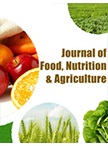Leaching behavior of vitreous fertilizers for application as plant nutrients
DOI:
https://doi.org/10.21839/jfna.2020.v3.325Keywords:
Glass fertilizer, Leaching, Plant micro-nutrients, Controlled- released, ProductivityAbstract
In view of significant role of macro and micro nutrient elements for increasing the food production to feed the growing population along with maintaining soil fertility, glassy fertilizers to supply the said need were prepared in the laboratory. The main objective of the present work is to study the role of different nutrient elements in the glass composition to be used as fertilizers. This has been aimed to provide a better substitution of chemical fertilizers because of its specific nature of leachability in aqueous medium. In the present research paper, the combined varying effect of different nutrient elements such as P, B, Zn, Fe, Cu, K and Si has been investigated using different experimental techniques.
Downloads
Download data is not yet available.
References
Bansal, N.P., and Doremus, R.H. (1986). Handbook of glass properties, pp 648, Acedemic press, New York.
Chaturvedi, R.K., Pyare, R., and Majhi, M.R., (2014). Role of low solubility glasses as a source of plant nutrient. Caribbean Journal of Science and Technology, 2, 457-463.
Chaturvedi, R.K., Singh V.K and Kumar A. (2008). Chemical corrosion of Glass. Indoceram, 45, 93-103.
Cox, G.A., and Ford, B.A. (1989). The influence of in homogeneities in glass on the morphology of the weathering layers. Glass Technology, 113-114.
Cox, G.A., and Khooli, A.R. (1992). The natural corrosion of glass; the formation of plugs.Glass Technology, 33, 60-62.
Javed, A., Singh, S.P., and Sandeep, S. (2013). Response of fababean to boron,zinc and sulphur application in alluvial soil. Journal of the Indian Society of Soil Science, 61, 202-206.
Paul, A. (1990) Chemistry of glasses, 2ndedn. P179, Chapman and hall, London.
Torrisi, B., Trinchera, A., Allegra, E. Rea, M., Roccuzzo, G., and Intrigliolo, F. (2013). Effect of organo-mineral glass matrix based fertilizers on citrus Fe chlorosis, European journal of Agronomy, 44, 32-37.
Varadachari, C., (1992). Phosphoric acid, phosphate and fertilizers for the future, Proceedings of the Indian National Science Academy B, 58, 119-126.
Waclawska, I., and Szumera, M. (2009). Reactivity of silicate –phosphate glasses in soil environment. Journal of Alloys and Compounds, 468, 246-53.
Chaturvedi, R.K., Pyare, R., and Majhi, M.R., (2014). Role of low solubility glasses as a source of plant nutrient. Caribbean Journal of Science and Technology, 2, 457-463.
Chaturvedi, R.K., Singh V.K and Kumar A. (2008). Chemical corrosion of Glass. Indoceram, 45, 93-103.
Cox, G.A., and Ford, B.A. (1989). The influence of in homogeneities in glass on the morphology of the weathering layers. Glass Technology, 113-114.
Cox, G.A., and Khooli, A.R. (1992). The natural corrosion of glass; the formation of plugs.Glass Technology, 33, 60-62.
Javed, A., Singh, S.P., and Sandeep, S. (2013). Response of fababean to boron,zinc and sulphur application in alluvial soil. Journal of the Indian Society of Soil Science, 61, 202-206.
Paul, A. (1990) Chemistry of glasses, 2ndedn. P179, Chapman and hall, London.
Torrisi, B., Trinchera, A., Allegra, E. Rea, M., Roccuzzo, G., and Intrigliolo, F. (2013). Effect of organo-mineral glass matrix based fertilizers on citrus Fe chlorosis, European journal of Agronomy, 44, 32-37.
Varadachari, C., (1992). Phosphoric acid, phosphate and fertilizers for the future, Proceedings of the Indian National Science Academy B, 58, 119-126.
Waclawska, I., and Szumera, M. (2009). Reactivity of silicate –phosphate glasses in soil environment. Journal of Alloys and Compounds, 468, 246-53.






 .
.